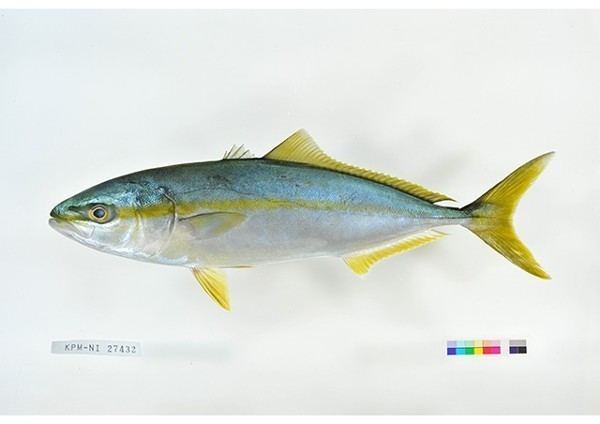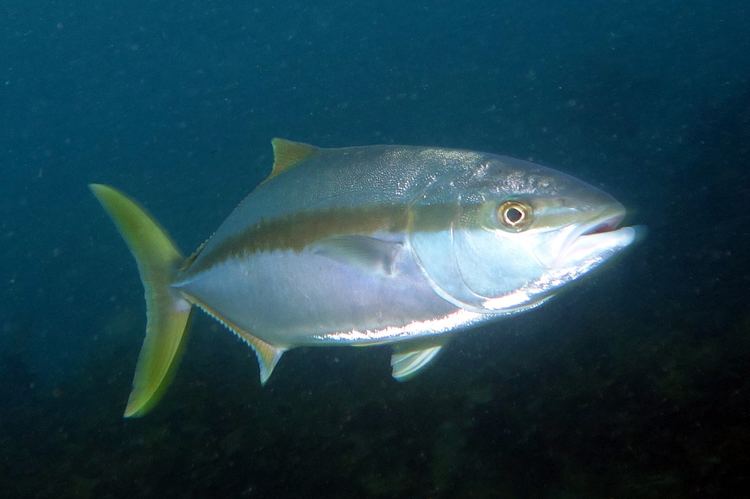Superclass Osteichthyes | Phylum Chordata Order Perciformes Scientific name Seriola Rank Genus | |
 | ||
Lower classifications Greater amberjack, Yellowtail amberjack, Japanese amberjack, Almaco jack, Samson fish | ||
Fish seriola rivoliana shoal
Seriola is a genus of bony fish, commonly known as amberjacks. Nine extant species are currently recognized, although these were formerly split into many more. Also, several species are currently placed in several other genera of Carangidae that were originally described under Seriola. They are a large, carnivorous finfish popularly known for the firm texture and rich flavour of their flesh, which make them an ideal fish for aquaculture. Because specimens caught can weigh up to 41 kg (90 lb), and are powerful swimmers and hunters, they are also highly prized by sport fisherman.
Contents
- Fish seriola rivoliana shoal
- Seriola dumerili greater amberjack heavy spin big game antalya turkey
- Aquaculture
- Species
- References

Most Seriola species are either benthic, demersal or pelagic, and can be found down to 200 m in depth. All 9 species cover most of the globe in terms of distribution, usually in coastal waters. Most are shown to be pelagic spawners, releasing eggs into the open ocean habitat until hatching, and they do this through dioecious, external reproduction. Most Seriola species are found in schools, and have diets consisting of fish, squid and other invertebrates.

Seriola dumerili greater amberjack heavy spin big game antalya turkey
Aquaculture

More than 150,000 tonnes of Seriola are produced through aquaculture per year. The majority is produced in Japan and Korea (Seriola quinqueradiata, Seriola dumerili and Seriola lalandi), with smaller contributions from New Zealand/Australia (Seriola lalandi) and America (Seriola rivoliana). Japanese yellowtail (Seriola quinqueradiata) accounts for more that 80% of global annual production. These cultured species are increasingly used in raw sushi, where they are known as hamachi, buri, kampachi and hiramasa.

Several trials are underway for land-based Seriola culture, but currently most Seriola fish are produced in cages, either in nearshore pens or in high-technology, submersible cages out in the open ocean. They are fed a range of diets, from trash fish to basic compound feeds to complex, formulated, compound feeds.

As is the case with the majority of aquaculture species, the farming of Seriola has associated environmental or other impacts.

With effective management of regulations and good farming practices, these problems can be avoided. To address these impacts, the WWF is creating the Seriola and Cobia Aquaculture Dialogue (SCAD). The purpose of the SCAD is to create standards that will minimize the key impacts of Seriola/Cobia aquaculture and move producers towards better performance. This will be done by identifying the key environmental and social impacts associated with the farming of three types of Seriola (S. rivoliana, S. quinqueradiata and S. lalandi) and cobia, and principles established for addressing each impact. Then criteria will be developed to provide direction on how to reduce each impact. It is open to all stakeholders, including producers and other members of the supply chain, researchers, NGOs, government officials and investors. The standards (to be finalised late 2011) will be adopted by the Aquaculture Stewardship Council, which will then work with independent, third-party entities to certify farms that are in compliance with the standards.
Species
There are currently eleven recognized species in this genus:
